Tennessee (17 October to 19 October)
After doing laundry and buying groceries, we made our way to Tennessee and the Great Smoky Mountains National Park. We decided to take Interstate-40 (I-40) for about 48 miles because we wanted to get to the park at a decent hour in order to get a campground spot. Wow, talk about a lot of 18-wheelers on the road. And they could only use the right hand lane of the divided four-lane highway. And despite a 50 mph speed limit for the trucks, they were passing us when we were going between 55-60 mph. Crazy. I’ve never been so glad to get off an interstate highway. We exited at Hartford, Tennessee and then pretty much traveled a number of backroads (thanks Google Maps – not) to get us to Gatlinburg, which borders one of the entrances to the park.
For the most part I like Google Maps. What I don’t like is some of the routes they suggest to get from point A to B. Some just don’t make sense. And then when you do chose the route you want, that voice may later say “We found a faster route. If you do not want to take this route, then press no, thanks” or something along that order. I selected the route I wanted. If I want something different, or faster, why not say “We found a faster route. If you would like this route, please press yes.” Are you listening Google?

Welcome to Tennessee
If you have never been to Gatlinburg, Tennessee, then let me warn you – it’s a very touristy place, at least the downtown area. We had stop and go traffic (not sure why), and there were hundreds of people along the sidewalks and coming out of various shops selling cheap tourist crap to expensive crap. Lots of restaurants too. We didn’t stop, in fact, I’m not sure anywhere to park.

Stop-n-go traffic on the main drag in Gatlinburg
The Great Smoky National Park was quite busy as well – a constant stream of traffic. We were lucky to get a campsite in the park. I guess this is the prime season for tourists in this part of the country – cooler, sunnier weather, the beginning of fall colors, and free park admission helps. I wish I had known about the high traffic season. I’m not one to visit a park when thousands of others have the same idea. Not my idea of enjoyable.
The park was created in 1934, following the purchase of over 6,000 tracts of private land in the 1920s and 1903s, by the states of Tennessee and North Carolina as advocates for a national park. Once a threshold of 250,000 acres was obtained then the National Park came into being. Today the park consists of 522,000 acres, and lies in both Tennessee and North Carolina.
The plant and animal life is quite diverse. The park is home to over 924 species of lichens. Eh gads, I didn’t know there were that many lichen species in existence, let alone in this small part of the U.S. The park also boasts over 1,500 different flowering plants, over 200 species of birds (Yay birds!!!), 60 mammals, and dozens of fish species. And just recently, the 1,000th species unique to the park was discovered. To top that, in the past 20 years, over 10,000 different species have been discovered in the park. Wow!!! This park is definitely species rich.
Since the park does not charge an entrance fee, it’s not hard to imagine why an estimated 11.0 million people visit per year. Fall (yes now) is a popular time to visit the park. There are nine campgrounds in the park, of which two stay open year-round: Cades Cove and Smokemont. Some of the roads through the park are closed in the winter due to snow. Note: many roads are narrow and their winding nature makes for some white knuckle driving.
There are four visitor centers, two historic grist mills, several restored farmsteads homes with accessory buildings, and plenty of trails – but if you want to know where the trails are and a little bit about them you will need to buy a hiking guide book at one of the visitor centers or spend $1.00 for a park trail map. There is a lot more I could say about the park, but just plan a visit here sometime. You won’t regret it.

Our route

Cute

Donations are critical
Once in the park, we drove down the Little River Road towards Cades Cove hoping to get a camping spot at the Cades Cove Campground. No luck. We turned around and went back to Elkmont Campground. Luckily they had about 20 (out of 220) sites left. We got a good one (G-25). I talked Jack into staying here another night so we went back and had to get a different campsite for the second night, but still within the same loop (G—23), although not as nice.

The road to Cades Cove – quite narrow

The “Little River”


Little River

This flower we’ve seen a lot in the eastern states along roadways.

Our campsite (G-25)
We did a quick hike of the nearby nature trail (had to find mushrooms to photograph), then came back to camp to fix dinner and retire for the evening. Tomorrow we plan to drive Newfound Gap Road, which traverses the park in a north-south direction.

Start of the Elkmont Nature Trail

The trees here are tall. Makes bird watching difficult since the warblers seem to like the tops of the trees.
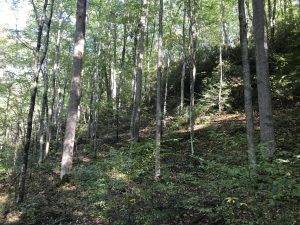

This bush is called “Dog-Hobble”. It produces purple berries.

Not sure what this plant is, but cute. – small twin leaves with red berries.

One of the 900+ lichens in the park. Or are there more than one on this log? Only the lichenologists know for sure.

Interesting type of lichen

One big mushroom – my hand for size comparison. I think this is one of the largest mushrooms we’ve seen yet.


These guys on the other hand were quite small

I didn’t “pose” these mushrooms. Nice to have a top and side view of the same species.

Not sure if this is a type of fungi or lichen – I would think fungi

Spindle Coral

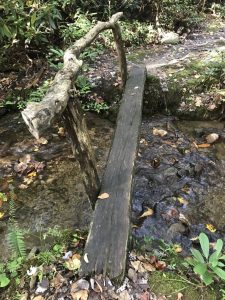

We left the campground around 9:00 am the next morning and headed towards the Newfound Gap Road, about five miles away. Already the traffic was heavy. At one trailhead – Alum Cave – the parking lot was full and they were already parking along side the road (and this was before 9:00 am, and it doesn’t start getting light out before 7:30 am). One the way back, I counted over 100 cars at this trailhead, and I know I probably missed at least 50 or more cars in my count. Crazy. A popular spot even though the trail is rated strenuous.
We drove to Clingman’s Dome where there is a short, uphill hike to an observation tower with a 360-degree panoramic view of the Great Smoky Mountains. And what a beautiful, spectacular view. When we arrived there were probably 30 cars in the humongous parking lot. We parked our van in a spot to enable an easy exit and then walked the paved path to the tower. This is not an easy hike, even though it is only ½ mile (one-way, and all uphill). This is a very, very steep path. I worried about some of the people walking up the path. The tower is at 6,643 feet elevation so the hike takes some exertion beyond just its steepness. The elevation really adds to the difficulty in hiking up from the parking lot, but the views are worth it.
When we returned to the parking lot we were amazed to find it was full of vehicles and many people were already parking their vehicle along the side of the road. To get to the dome you take a seven-mile side road off Newfound Gap Road. Coming down this side road, I counted over 150 cars going up. We wonder where they all parked. Crazy, crazy, crazy.
We continued on the main Newfound Gap Road stopping at the Mingus (grist) Mill and then the Oconaluftee Visitor Center (say that fast even once or at all), which includes a Mountain Farm Museum. There are signs to stay out of the fields if elk are present. Well elk were present, but people seem to think the signs don’t apply to them. This is a pet peeve of mine. If someone were to get attacked by an elk then they would blame the park service for their injuries, despite the signs. People want to disobey the rules, but they don’t want to pay the consequences for their actions – whether it is injury or simply a fine. People – take responsibility for your actions.






This photo doesn’t really show how steep this trail really is – quite steep. “Everyone” was huffing and puffing.

The walkway up to the observation tower. I guess the old tower was wooden with steps that went straight up to the top.

The observation Tower where you can get a 360 degree view of the Great Smoky Mountains National Park – I could see both Tennessee and North Carolina (which is quite easy since Clingman’s Dome is almost on the border of the two states.

Jack on the walkway up to the top of the observation tower

View from the top






Nature Trail we took on the road down from Clingman’s Dome


This is actually a bench. I don’t think it’s been used in quite some time.





Mingus Grist Mill

Inside of the mill





Meadow Farm Museum


Yes, then even had live pigs

The one on the left was wondering if the one on the right had found something good to eat in the mud – yuck…

Now if you have a point and shoot with a zoom lens like mine then you can get the photo without having to get too close
We finished the drive and returned to our campground – no more fighting traffic and congestion. But it was still early so we decided to hike the Little River trail near the campground. The trail is relatively flat and wide, and parallels the Little River, which is quite a beautiful, boulder-strewn, scenic stream. We even spotted a river otter swimming, diving, and emerging to feed while sitting on the rocks. At one point it was bashing some food item on the rock before eating it – a crayfish perhaps?

Nice wide trail (former road) for the Little River trail

Little River



Don’t know the name of this falls, but just off the trail


Now this is a tenacious tree



Chimney from one of the old homes

When we stopped at the campground office to get our tag and sign the form agreeing to keep a bear- free campsite (no food items or odors left outdoors, subject to an $80 fine), we were told they didn’t have a record of us having reserved the site, despite our receipt showing payment. Come to find out the ranger put in Jack’s name as “John Miles”. That could make a difference. Luckily we caught their mistake and got it straightened out. The campground was full so not sure what we would have done otherwise.
The next morning we decided to drive the Cades Cove Loop Road, which was just as busy as the Newfound Gap Road. We started out earlier on this road (about ½ hour) and had little traffic on the way to the loop road, but once there it was like all the cars just came out of the wood work (or woods…). Again, bumper to bumper traffic. Most people were nice and would let you out if you stopped to check out some of the historic buildings of the area.
In Tennessee vernacular “cove” essentially means a flat valley between mountains or ridges. This was a good sized cove and in its heyday (1850s), there were 685 residents (consisting of 132 families). We did make several stops, including several homesteads, one owned by John Oliver and another by his son Elijah Oliver. We stopped to check out the Cable (grist) Mill at the Cades Cove visitor center. They have interpretive panels and a person in the mill talking about how the mill was built and operated and even selling cornmeal and whole wheat.

The day started out foggy once we got to Cades Cove

John Oliver’s Home

You really don’t realize how many spider webs are out there until they are covered in dew or the sunlight hits them. There were a lot.





The loop road through Cades Cove is one way




The Cable Mill




Cantilevered Barn

Jack liked this use of horseshoes

Elijah Oliver’s House

Jack checking out the old buildings




This barn was on the property owned by Elijah Oliver

Barn at the Cable Mill


Spring house at Elijah Oliver’s homestead. They got water here, but also kept items cold.

This is one of the old churches remaining from when the cove was occupied by homesteaders. This is a Methodist church.

A lot of the gravestones where for infants. Many died on the same day they were born.
After leaving the loop, we headed out of the park and into Townsend, Tennessee to gas up and get a few groceries. I ran out of coffee so we stopped at the IGA store. I like Starbuck’s Café Verona Decaf. The store had five different kinds of Starbuck’s coffee, none of which were Café Verona let alone Decaf Café Verona. Will need to try a larger store.
We took the park’s Foothills Parkway and headed south. At the end of the parkway, we turned left and shortly entered the road from hell – Highway 129! If you get car sick (luckily I don’t), then this is NOT the road for you. An eleven (11) mile section of road has so many turns (318 to be exact) – first left, then right, and up then down, and on and on and on – you got dizzy. Some of the drop offs were quite steep and without guardrails, which added to the nerve-racking experience. And despite the 30 mph speed limit (15 mph on the corners) there were people who wanted to go faster. Not me. And there must have been over 100 motorcyclists on the road. Luckily most were coming from the opposite direction rather than on our tail. Jack thinks the motorcyclists like the road because they can go fast on the banked curves. We saw a lot of sports cars on the road too. I was never so happy to get off a stretch of road as I was that one. I did see evidence where at least two people didn’t make a turn (crosses along the roadway). They do have pull-off areas so you can pull over and let others pass. At five of these pull-offs there were people there with cameras taking commercial photos. I guess if you want a photo of yourself screaming around a corner (in my case with a grimace on my face), they will sell you one. There were two different companies: 129 Photographs and Killboys. Oh, and we didn’t know about this road before we decided to go this way to reach our campground for the night.

We had to buy a sticker to commemorate our achievement.

We re-entered North Carolina and found a campground (Chetoah Point) in the Nantahala National Forest. The 23-site campground has flush toilets, showers, and six electrical sites (on-line reservation required). Not a bad little campground. Tomorrow we headed into Georgia.

Like the sign – no spraying or mowing

View of our lake from the campsite
We didn’t really spend a lot of time in Tennessee, nor did we see much of the state. All of the National Wildlife Refuges are located in the western portion of the state. And since we are headed towards Florida, I decided to catch those refuges on another visit when we can also go to the sole Kentucky refuge and visit some refuges in Arkansas as well. Ah, so many refuges yet to visit…
We woke to a very wet day. Well, we did go three days with full on sun or mostly sunny skies so I shouldn’t complain. We left the campground without making breakfast because our picnic table was surrounded by about an inch of water from all the rain we had during the night. Off we went.

I took this photo when I opened our van door to step out
Georgia (20 October – 26 October)
Most of the day was spent driving. About two hours after leaving our campsite we entered Georgia – the Peach State. We went through the town of Helen, a Bavarian themed town with buildings and business names along that theme. There were lots of people out celebrating Oktoberfest. We kept going. Jack wondered where everyone parked – maybe at their hotels???
We stayed the night at a U.S. Forest Service campground – Lake Sinclair. We didn’t care for this campground. Most of the camp sites weren’t level, nor well-maintained. Of course we didn’t mind the fee – $4.50 per night senior rate. We spent one night here.
Despite the lack of level ground, there were a lot of trees and water, and thus some good birds: Red-bellied Woodpecker, Downy Woodpecker, Pileated Woodpecker, Yellow-bellied Sapsucker, Tufted Titmouse, Carolina Chickadee, Great Blue Heron, Great Egret, Eastern Phoebe, Belted Kingfisher, Turkey Vulture, and Northern Cardinal. I was (bird) happy.

Ruby-crowned Kinglet

Our campsite – Jack at our picnic table in the morning fixing coffee. The picnic table was under a tree where cones kept dropping. You almost needed a hard hat.
We visited the 35,000-acre Piedmont National Wildlife Refuges, which was established in 1939. The refuge was about 30 miles from our campground. I really like this refuge. Lots of mixed hardwoods and pines. Just beautiful. Of course it helped it was sunny. We hiked the 2.9 mile Red-cockaded Woodpecker Trail hoping to see one of these endangered woodpeckers, but no luck. We have seen these woodpeckers on several occasions on previous trips, but always nice to see them again. Despite the lack of the Red-cockaded Woodpecker, we did have some nice mixed flocks that included a family of Wood Thrushes. None of the birds, except a Yellow-bellied Sapsucker, were very accommodating for the camera. We did see a number of large spiders. Luckily their webs didn’t cross the trail. I usually walk ahead of Jack on trails because I see and hear the birds more than he does, but then I get the privilege of running into spider webs. Luckily most of them are single threads across the trail – a bridge between two large webs???

Another refuge to add to my refuge “life” list


Sign for the Red-cockaded Woodpecker Trail





There was actually one gravestone here for a person, not a woodpecker


Red-cockaded Woodpecker nest tree

Yellow-bellied Sapsucker

Nasty looking spider

The refuge did include an auto tour route, but there wasn’t a lot of bird activity except at the very beginning – lots of Chipping Sparrows alongside the road, plus a female Northern Cardinal. We did see a Palm Warbler on the road hawking for insects. This little warbler likes to flick its tail so that helps in identification especially during the non-breeding season.




We left the refuge and headed to High Falls State Park for the night. We took a wrong turn right before the park and ended up at a recycling facility. However, we were told ONLY Monroe County residents could deposit recyclables there. Even with no one around, the guy was very adamant about the rule, but handed us a flyer showing what could be recycled. I tried joking with him, but he took his job very seriously. I asked him whether I should write the Governor to complain, but he mumbled that wouldn’t do much good. I guess the county would rather we contribute to their landfill?
The High Falls State Park campground has two loops – Lakeside and Riverside. We chose the Riverside as it offers more camp sites. We selected #37, which is located near the restrooms, but still gives us plenty of privacy. And speaking of restrooms – you get flush toilets, HOT showers (Yay!!!), and laundry facilities. Unfortunately, I had recently done laundry so no need for the coin-operated washer and dryer. Each campsite has electricity and water. Of course for all that you pay $37.45 per night. Georgia doesn’t charge an out-of-state fee, which is nice, nor do they add on a day-use fee.

One of the “MANY” Grey Squirrels near our campground. This one was either digging something up or burying it.

Our campground site
Our next refuge to visit was the Bond Swamp National Wildlife Refuge (NWR) – another new refuge for us. This refuge, located just south of Macon, Georgia, was established in 1989 – so a fairly new refuge. This is a small refuge – only 6,500 acres – with several trails, but no auto route. We walked/birded the Longleaf Pine Trail (1.9 miles). We did get some good birds including an Eastern Towhee, Carolina Wren (gotta love those wrens), and a first for the year (FOY): Northern Mockingbird. I would have thought we would have seen mockingbirds before now. In some places they are actually a nuisance. This trail wasn’t as well maintained as the Red-cockaded Trail at the Piedmont NWR. Also, no one had been on the trail recently as there were a number of webs across the trail. Luckily the sun was shining and we could see the webs before we ran into them. Now these spiders were really big, so not something you want to get ‘tangled up’ with.



Longleaf Pine Trail

We weren’t quite sure what this was?


These little fungi were quite pink


Northern Mockingbird

There always seems to be an Eastern Phoebe

We saw a lot of these spiders along the trail – they’re big
While we were making our way south I luckily had internet connection. We thought we should try and book our campground reservations for Florida. All those snowbirds and locals might result in full campgrounds if we don’t book ahead, and it is good we did. At two of the four campgrounds we booked there were only a couple of sites left to chose from. One reason we prefer not to book ahead is that we like to see what a campsite looks like before we chose it – is the site level, how close are one’s neighbors. That type of thing. And we were hoping to spend some time camping on the Florida Keys. No luck there. There are three state parks on the Keys. One is closed for reconstruction, and the other two are booked already – no space at the inn, so to speak. We did decide to spend at least one day on the Keys and booked a beachside cottage/bungalow near Key Largo. If we like the Keys area, then maybe we will come back sometime.
After the refuge we headed to General Coffee State Park near Valdosta, Georgia. This is a nice little park with plenty of hiking trails. They also have a heritage farm with goats, horses, donkeys (I love donkeys), sheep, chickens, and domestic ducks. While I said this was a nice “little park”, it is actually good size as it was almost 1.5 miles from the park office at the entrance to our campground loop. In Georgia they call their visitor centers/parks offices “Trading Posts”. After setting up our campsite, we visited the heritage farm and did a short hike.

We saw this store in a small town that probably had a population of less than 1,000, and we wondered how it could stay in business

General Coffee State Park “Trading Post”


One of the “domestic” ducks

Turtle

Isn’t this donkey just the cutest, most precious thing you ever seen? I wanted to take the donkey home.

Goat

This one was hoping I had some food for it to eat. You can buy pellets, but the dispenser was empty.


Great Egret

Pond near the Heritage Far

A boardwalk we took as part of our hike in the park

Starting to get into “cypress swamp” country – Yay!!!


Cypress knees – do they support the adjacent tree or aerate the tree’s roots


Tangled vines




I like this interpretive sign about what the area may have looked like during four different periods of time
The next morning we stopped at the Banks Lake National Wildlife Refuge (another new refuge for us). This refuge was created in 1985 and is 3,559 acres – they keep getting smaller. Banks Lake is a natural Pocosin (wetland with deep, acidic, sandy, peat soils), believed to have been created by tidal action thousands of years ago. The federal government purchased the land from the Nature Conservancy who bought it from the E.D. Rivers Estate in 1980. The estate had threatened to drain the lake and harvest the cypress tree and stumps. Go Nature Conservancy.
The refuge has a boardwalk/short trail, which we walked. We had thought we would see waterbirds on the lake, but no luck. In fact, there wasn’t a single bird on the lake. Kind of eerie. There were several people fishing, and you can rent canoes and kayaks to use on the lake. Surprisingly, although there weren’t any birds we did find some along the trail, including a White-eyed Vireo (first of year) and one of my favorite warblers: Common Yellowthroat. And it wasn’t easy finding these birds as the vegetation along the trail where the birds were feeding was quite thick.



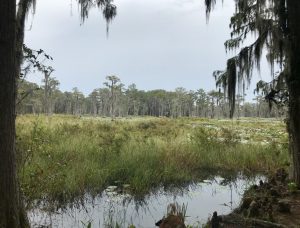


Try and find birds in this vegetation

Not sure what this plant is but the Gray Catbirds like the berries

We are now in “Cotton Country”
We drove into Valdosta to get groceries and to print out an online delivery absentee ballot application form so we can have the general election absentee ballot emailed to us. There are some important races (U. S. House of Representatives and our State legislature and Governor) and a ballot measure pertaining to salmon that we want to make sure we vote on. Every vote counts and it is one of our rights we should not take for granted and ignore.
After Valdosta we drove to Stephen Foster State Park, which is located in the Okefenokee Swamp National Wildlife Refuge (NWR). The 402,000 acre Okefenokee NWR was established in 1937 after the area was heavily logged. This refuge covers 630 square miles. That is a BIG refuge (by lower 48 standards). In 2011 there was a fire (Honey Prairie Fire) here that burned more than 75% of the refuge and burned for over 11 months. I do remember hearing about it at the time. The fire was started by lightening.
The Okefenokee Swamp (actually considered a bog) is maintained by rainwater, and births two rivers: St. Mary’s and Suwanee. Over 354,000 acres of the 402,000- acre refuge is designated wilderness. The refuge is also listed as a Ramsar site – a wetland of international importance.
We plan to camp at the park for two nights. After setting up camp we did take a walk around the campground loop as we heard the loud drumming of a Pileated Woodpecker and wanted to check it out. And as usual, there were some good birds in the campground. We then headed towards the “Trading Post”. We signed up to take a boat tour of the swamp the next day. We did this same tour in 2014 on our “Big Year Adventure”. At the boat dock ramp there was the resident alligator with a portion of its head sticking out of the water as if challenging someone to launch a canoe or kayak.



This alligator hangs out where you put in your kayaks and canoes
Near the Trading Post is a nature trail, which called out to us – “Come See What Birds Are Here”. So off we went and we were not disappointed. A short distance along the trail is a side trail consisting of a 2,100 feet boardwalk – well part of a 2,100 foot boardwalk. It was near the end of the boardwalk where all the bird activity seemed to be occurring. We had two Pileated Woodpeckers, including one drumming in an overhead tree adjacent to the boardwalk. Great view of this magnificent bird! There were three Gray Catbirds mewing their protest at the four Red-Shouldered Hawks in the area (I think this was a family). We also heard a Barred Owl hooting away, and there were also several Yellow-bellied Sapsuckers and a Little Blue Heron (first of year bird for me). When we got back to the Trading Post we heard not one, but three Barred Owls. We tried to locate them, but no luck. Dinner was calling so back to the campsite we went.


I like how they reuse signs for different purposes – like this nest box

Northern Mockingbird

Nature Trail

Boardwalk – side trail from nature trail

I think they may have lost a portion of the boardwalk and are beginning repairs. We could see the continuation of the boardwalk about a 100 yards beyond these boats.

More cypress knees

This Pileated Woodpecker was on a tree adjacent to the boardwalk

Pileated Woodpecker

Plenty of Gray Catbirds along the boardwalk trail


Spanish Moss, which isn’t a true moss, but rather a member of the pineapple family (bromeliad)

Brown Thrasher

Wild Turkey …

… feeding alongside the White-tailed Deer

Our campsite
After a restful night we hit the trails again starting with the Fitness Trail, which runs along the backside of the campground. The morning birding here was fantastic. We had 12 species in this birding ‘hot spot’, including five woodpecker species: Pileated, Red-bellied, Yellow-bellied (sapsucker), Red-headed, and Northern Flicker. We also had three vireo species: Blue-headed, White-eyed, and Yellow-throated, as well as numerous Gray Catbirds and Northern Cardinals. The birds definitely like to flock together.

Fitness Trail – great birding

Pileated Woodpecker – these birds when they drum are loud. Can’t mistake it for any other woodpecker in the U.S.

Luckily no activity at this nest – it was a big nest

The Trading Post and boat launch area
From the Fitness Trail we headed back to the nature trail near the Trading Post. We walked the entire trail today, and were happy to see a Yellow-billed Cuckoo. We found this bird, when we heard another bird calling. If there is movement in the trees we check it out because otherwise we probably would not see many species as most are not calling or singing at this time of year (molting and not breeding so no breeding plumage or mating behavior).

Nature Trail

Beggar’s Tick Sunflower

Lots of Spanish Moss in a cypress swamp



After lunch we took our 1.5-hour park sponsored boat ride ($15.00 per person) with the park naturalist. We did see at least 24 alligators along the slightly greater than one-mile waterway we took through the swamp. We could see areas where the 2011 Honey Prairie Fire had burned and areas left unaffected by the fire. And the yellow native flowering Beggar’s Tick Sunflower was prominent in these burned areas. The seeds like to hitch-hike onto birds or insects and then disperse later by falling off the animal. The flowers do not attract ticks, luckily. This flower is very pretty.

Heading out a channel into the swamp


Luckily they have directional signs

We were told that this tree was almost 1,000 years old


Alligator cooling off

You can tell the length of an alligator by measuring (okay estimating because you don’t want to get “that” close) the length between its eyes and its nostrils. For instance if the distance is 10 inches, then the alligator is 10 feet in length.

It truly is an amazingly beautiful area









We flushed these two White Ibis into this tree



This Eastern Phoebe was hawking for insects over the swamp waters

I’ve never seen a phoebe clinging to the side of a tree

An adult Little Blue Heron


Anyone can put in their own boat and paddle away. There are over 70 islands within the swamp, and luckily for boaters (motors limited to less than 10 horsepower) there are signs directing you to different parts of the refuge via water trails. You can get a permit to camp throughout the refuge, but access is by boat only. The only campground you can drive to is the one we are staying at: Stephen Foster State Park, operated by the state of Georgia. The naturalist said if boaters get lost they only need to follow the flow of the water as the water exits the refuge through one of two rivers: Mary’s River or the Suwanee River.
With such a peaceful existence at the park, we decided to stay another night at the campground and visit the east side of the refuge with its visitor center and auto tour drive. To get there we needed to drive 60+ miles. Along the way we did see a number of hunters with dogs. We suspect they were hunting wild boar. An agricultural agent (we had to stop for an inspection as we enter into Florida for a short portion of the trip), said the hunters use mutt dogs because if the dogs gets gored or badly injured they just leave the dogs out there to die. He said he has seen a number of injured dogs just wandering the roads. We later saw a dog walking along side the road. He didn’t look injured, but he obviously got lost or left behind. I love dogs so I guess I have a hard time seeing them used cruelly or merely as a tool to an end. Most of the dogs we saw were a Beagle mix.
The weather cooperated and didn’t rain on us while we were checking out the eastern portion of the refuge. At the main entrance (near Folkston, Georgia) we stopped to pick up information, watch a movie, and a purchase a magnet at the visitor center.


This jutebox plays calls for some of the various animals found in the Okeefenokee Swamp. Cute.

The prescription bottle reads: Take 1 Forest Fire every 3 to 5 years or as needed.

Cute bench
We then drove the 7-mile Swamp Island Drive. Along the drive we did the 0.25-mile upland trail hike (last time we were here, we saw an Eastern Screech Owl and we were hoping that four years later the tree was still there and an owl would also be at the hole – no luck with the owl, although the tree was still there). We also stopped and toured the Chesser Homestead (learn what it is like to have lived in the area in the early 1900s), then walked the 0.75-mile boardwalk (one way – now that’s an expensive boardwalk with Trex decking and a sprinkler system to protect it from a future wildfire). The trail leads to the 40-foot Owl’s Roost Observation Tower. This very secure tower gives you an almost 360-degree view of the refuge. We did see several alligators along the drive. Back at the visitor center, we did a short hike – the Cane Pole trail that parallels the canal from the visitor center into the waters of the refuge, before heading into Folkston, Georgia for dinner. The refuge volunteer at the Chesser Homestead told us the Thai restaurant in Folkston was very good. We had to check it out. Although it was good, I still like the one in New Hampshire better.

Swamp Island Drive

Water lily in a canal along side Swamp Island Drive

This is when it is nice to have a point and shoot camera with a zoom len, as my iPhone camera could not have captured this water lily very well. I didn’t want to get too close to the canal as there could be an alligator lurking nearby.




We were told this plant was the Florida Paintbrush. The plant was at least 2-3 feet tall. Tallest paintbrush I’ve ever seen.

Artificial nest box for the Red-cockaded Woodpecker. They are seen here in the park, but we didn’t see them unfortunately.

House Wren

House Wren

Trail to the Chesser Homestead

Chesser Homestead Cabin

This little guy greeted us upon arrival at the homestead. I was even able to touch its tail.

I love this saying – “The Earth Has Music For Those Who Listen”

Blue Goose bike racks at the Boardwalk Trail


This boardwalk was quite wide. Not your typical boardwalk.

View from the Owl’s Roost Tower


View of the boardwalk from the observation tower

I love the spanish moss – so southern

This guy was along the road. What a big alligator.

More cypress knees

Little Blue Heron near the visitor center

Little Blue Heron

Cane Pole Trail

Canal that leads out into the swamp from the visitor center

View of the “prairie” from a platform at the end of the Cane Pole Trail
If we ever return to the Okeefenokee National Wildlife Refuge for another visit we will stay longer (at the Stephens Foster State Park) and rent kayaks or a motor boat to really get out and explore the refuge. I really hated to leave.
Next up is Florida – the Sunshine State. I hope so. Until then …
IT’S A GREAT DAY TO BIRD










































































































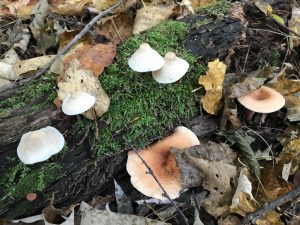





































































































































































































































































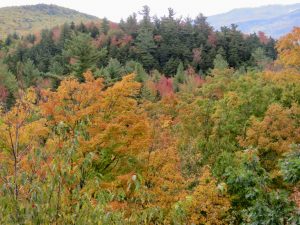



































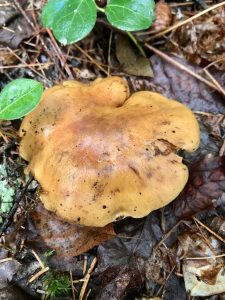













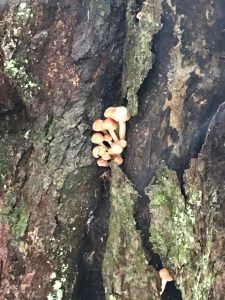































































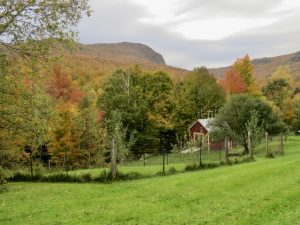






















































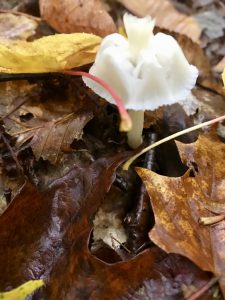











































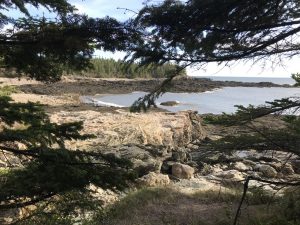














































































































































































































Recent Comments